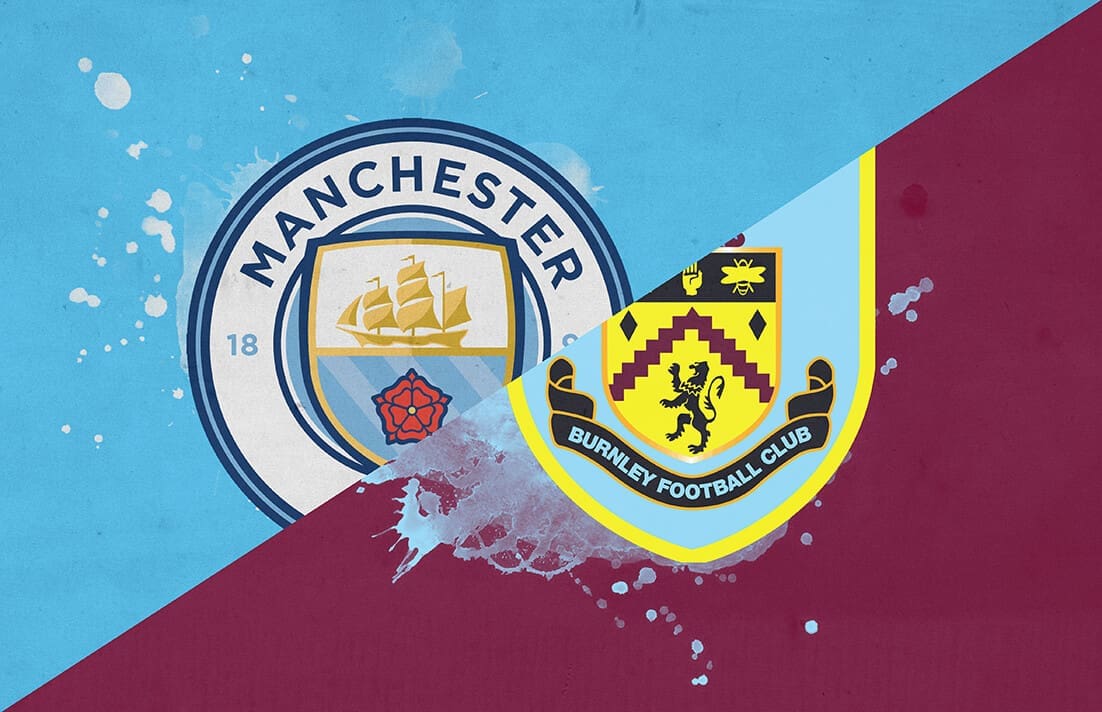This Premier League match analysis was originally featured on our network’s Manchester City site manchestercityanalysis.com.
The international break is loved by the ones that like to see top-quality players competing against each other for their countries, but also hated by others, a little like the week-to-week action of club football. The latter were happy to see the return of a Premier League season that is showing several contenders playing at a very high level, including Liverpool, Manchester City, Chelsea, and Arsenal among others. The Citizens were faced against Burnley FC, a team that played preliminary rounds of the UEFA Europa League for the first time in 51 years, and that brought Joe Hart back to Etihad Stadium. However, they have struggled to find regularity in the league games. We prepare a tactical analysis of Guardiola’s team that ended with a comfortable 5-0 win against Sean Dyche’s men.
USUAL TACTICAL SETUP, DIFFERENT ATTACKING APPROACH
When looking at the initial formation, the classic 4-3-3 arose with not many surprises in the middle and forward lines. But Kyle Walker’s injury during the international break forced Guardiola to change the defensive line. With Kompany and Laporte as centre-backs and Mendy as a left back, John Stones was the chosen one to replace Walker on the right side. With all the natural limitations he has to perform that role, slower speed, lack of offensive pace and creativity, among others, he actually showed a solid performance worth highlighting. Without shining, he was extremely precise in his passing (97% precision), and he only lost possession four times, none of them in Man City’s own half, showing Pep that he has a very good alternative in that position when needed.

As expected by any team coached by Guardiola, the initial formation gave place to interesting tactical movements during the game. The build-up phase saw Fernandinho moving back as a sweeper between Kompany and Laporte, forming a three-man defensive line, while Stones and Mendy moved forward ahead of the back three. This lengthened Burnley lines creating free spaces for both David and Bernardo Silva to receive the ball in the middle of the field. David Silva was one of the top performers for Man City during this game, excelling in his movements off the ball, which allowed him to receive the ball with some space and cause danger for the Citizens. He hovered all around the pitch, leaving Burnley’s men with no reference as to where to mark him. He fell back to receive the ball from the defenders, was wide open and connecting with Sane, and even was found alone several times without a challenge inside Burnley’s area.

Offensively, we saw an inverted attacking setup. While the usual figure is to see the two inside midfielders, in this case, David and Bernardo Silva, and the two wingers, Sane and Mahrez, in one line, and then Agüero as classic centre-forward, during this game Kun fell back to receive the ball as David and Bernardo Silva moved forward closer to Burnley’s centre-backs, allowing Agüero to receive the ball with enough space to turn around and progress with the ball. This movement caused one of the centre-backs to step forward to prevent Agüero from continuing to advance with the ball leaving more spaces for the four attackers Man City had put ahead of the Argentinian.

This offensive setup resulted in an attacking 2-3-1-4 strategy that proved efficient to open up spaces, especially on the sides, as having Agüero and both Silvas attacking through the centre freed spaces for both wingers. And surprisingly enough, one of the most dangerous attacking weapons City showed, especially during the first half, were crosses into Burnley’s goal area, mainly from Mahrez’ side, where Agüero and David Silva managed to find spaces and almost beat Hart, none of them tall guys that usually win those balls.

We saw different offensive schemes on each side of the attack; while on the right side the attacking was mostly based on Mahrez individual efforts, probably because of Stone’s less offensive approach, on the left flank we saw a much more collective approach, with David Silva and Sane showing very cohesive movements with the support of Mendy’s fast runs next to them. And when looking at Man City’s goals, all of them on the left flank were involved in some capacity. Mahrez did not have a great game, although after Kevin De Bruyne and Foden’s substitutions, more space was freed for him and he participated more in the game, including the very nice goal he scored that will probably reduce, but not remove, the pain of the missed penalty against Liverpool.
Burnley, on the other hand, played a defensive 4-4-1-1 and never managed to create a lot of danger in the Manchester City half. They did apply some intense pressure to the home defensive line during the build-up phase, but it was without consistency and strength, and mostly done during throw-ins and goal kicks of Manchester City. If the initial pressure didn’t work, they would move back and wait in their own half. Offensively, they didn’t even manage to have one shot in Manchester City’s goal and most of their attempts were based on long balls into Burnley’s number nine, Sam Vokes, looking for him to win the header and getting the ball to one of his teammates that would run past him.

Manchester City reacted to that, and during the second half, the team was smart enough to reduce the usual intense pressure and waited for Burnley’s players to advance with the ball close to the middle of the pitch, reducing the number of long balls played to their forwards, as spaces were much more reduced at that point.

SUMMARY
Burnley didn’t manage to upset Manchester City’s good run in the Premier League. Although the home team were only able to lock the game during the second half, they were never really at risk of losing control of the match. The real challenge will come during the week when they travel to Ukraine to visit Shakhtar Donetsk for the UEFA Champions League.





Comments